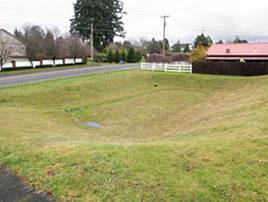
Difference between revisions of "BMPs for stormwater infiltration"
m |
m |
||
| Line 52: | Line 52: | ||
| High | | High | ||
|- | |- | ||
| − | | colspan="4" style="text-align: center;" | <font size=1><sup>1</sup> Due to a size restriction; | + | | colspan="4" style="text-align: center;" | <font size=1><sup>1</sup> Due to a size restriction; <sup>2</sup> Unless the infiltration practice is located in an industrial area with exposed significant materials or from vehicle fuelling and maintenance areas. Infiltration BMPs are PROHIBITED in these areas; <sup>3</sup>Underground infiltration systems will have different pollutant removal capabilities than what is provided in this table. These systems may have a wider application range, however, there is concern that they do not provide adequate treatment of the pollutants; <sup>4</sup> This is only for the portion of flow that enters the infiltration basin; by-passed runoff does not receive treatment; <sup>5</sup> Low = < 30%; Medium = 30-65%; High = 65 -100%); <sup>6</sup> Assumes adequate pre-treatment</font size> |
| − | <sup>2</sup> Unless the infiltration practice is located in an industrial area with exposed significant materials or from vehicle fuelling and maintenance areas. Infiltration BMPs are PROHIBITED in these areas; | ||
| − | <sup>3</sup>Underground infiltration systems will have different pollutant removal capabilities than what is provided in this table. These systems may have a wider application range, however, there is concern that they do not provide adequate treatment of the pollutants; | ||
| − | <sup>4</sup> This is only for the portion of flow that enters the infiltration basin; by-passed runoff does not receive treatment; | ||
| − | <sup>5</sup> Low = < 30%; Medium = 30-65%; High = 65 -100%); | ||
| − | <sup>6</sup> Assumes adequate pre-treatment</font size> | ||
|} | |} | ||
An infiltration basin is a natural or constructed impoundment that captures, temporarily stores, and infiltrates a design volume of water. | An infiltration basin is a natural or constructed impoundment that captures, temporarily stores, and infiltrates a design volume of water. | ||
Revision as of 21:58, 21 May 2015
Best Management Practices that infiltrate stormwater runoff into underlying soil include, but are not limited, to
- infiltration basins,
- infiltration trenches,
- underground infiltration,
- bioinfiltration,
- permeable pavements, and
- tree trenches and tree boxes.
These are discussed briefly below.
Infiltration basin
| Applications | Treatment capabilities3, 4, 5 | ||
| Residential | yes | TSS | High6 |
| Commercial | Yes | TN | Medium/high |
| Unltra-urban | Limited1 | TP | Medium/high |
| Industrial | Yes2 | Chloride | Low |
| Highway/road | Limited | Metals | High |
| Recreational | Yes | Oils and grease | High |
| Pathogens | High | ||
| 1 Due to a size restriction; 2 Unless the infiltration practice is located in an industrial area with exposed significant materials or from vehicle fuelling and maintenance areas. Infiltration BMPs are PROHIBITED in these areas; 3Underground infiltration systems will have different pollutant removal capabilities than what is provided in this table. These systems may have a wider application range, however, there is concern that they do not provide adequate treatment of the pollutants; 4 This is only for the portion of flow that enters the infiltration basin; by-passed runoff does not receive treatment; 5 Low = < 30%; Medium = 30-65%; High = 65 -100%); 6 Assumes adequate pre-treatment | |||
An infiltration basin is a natural or constructed impoundment that captures, temporarily stores, and infiltrates a design volume of water.
